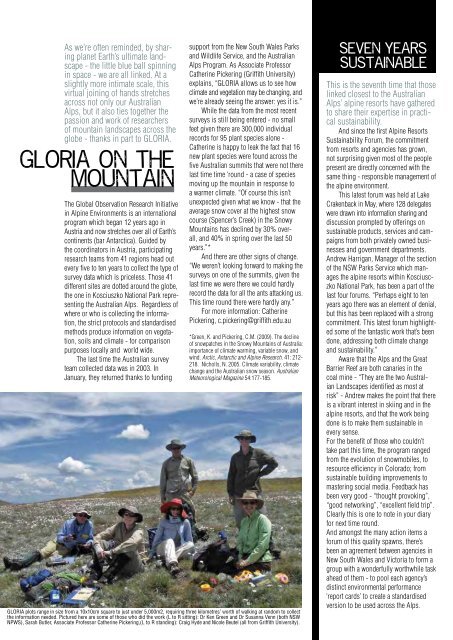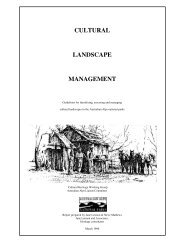Download Newsletter number 42 ( PDF - 1.25 MB) - Australian Alps ...
Download Newsletter number 42 ( PDF - 1.25 MB) - Australian Alps ...
Download Newsletter number 42 ( PDF - 1.25 MB) - Australian Alps ...
- No tags were found...
You also want an ePaper? Increase the reach of your titles
YUMPU automatically turns print PDFs into web optimized ePapers that Google loves.
As we’re often reminded, by sharingplanet Earth’s ultimate landscape- the little blue ball spinningin space - we are all linked. At aslightly more intimate scale, thisvirtual joining of hands stretchesacross not only our <strong>Australian</strong><strong>Alps</strong>, but it also ties together thepassion and work of researchersof mountain landscapes across theglobe - thanks in part to GLORIA.gloria on themountainThe Global Observation Research Initiativein Alpine Environments is an internationalprogram which began 12 years ago inAustria and now stretches over all of Earth’scontinents (bar Antarctica). Guided bythe coordinators in Austria, participatingresearch teams from 41 regions head outevery five to ten years to collect the type ofsurvey data which is priceless. Those 41different sites are dotted around the globe,the one in Kosciuszko National Park representingthe <strong>Australian</strong> <strong>Alps</strong>. Regardless ofwhere or who is collecting the information,the strict protocols and standardisedmethods produce information on vegetation,soils and climate - for comparisonpurposes locally and world wide.The last time the <strong>Australian</strong> surveyteam collected data was in 2003. InJanuary, they returned thanks to fundingsupport from the New South Wales Parksand Wildlife Service, and the <strong>Australian</strong><strong>Alps</strong> Program. As Associate ProfessorCatherine Pickering (Griffith University)explains, “GLORIA allows us to see howclimate and vegetation may be changing, andwe’re already seeing the answer: yes it is.”While the data from the most recentsurveys is still being entered - no smallfeet given there are 300,000 individualrecords for 95 plant species alone -Catherine is happy to leak the fact that 16new plant species were found across thefive <strong>Australian</strong> summits that were not therelast time time ‘round - a case of speciesmoving up the mountain in response toa warmer climate. “Of course this isn’tunexpected given what we know - that theaverage snow cover at the highest snowcourse (Spencer’s Creek) in the SnowyMountains has declined by 30% overall,and 40% in spring over the last 50years.”*And there are other signs of change.“We weren’t looking forward to making thesurveys on one of the summits, given thelast time we were there we could hardlyrecord the data for all the ants attacking us.This time round there were hardly any.”For more information: CatherinePickering, c.pickering@griffith.edu.au*Green, K. and Pickering, C.M. (2009). The declineof snowpatches in the Snowy Mountains of Australia:importance of climate warming, variable snow, andwind. Arctic, Antarctic and Alpine Research. 41: 212-218. Nicholls, N. 2005. Climate variability, climatechange and the <strong>Australian</strong> snow season. <strong>Australian</strong>Meteorological Magazine 54:177-185.GLORIA plots range in size from a 10x10cm square to just under 5,000m2, requiring three kilometres’ worth of walking at random to collectthe information needed. Pictured here are some of those who did the work (L to R sitting): Dr Ken Green and Dr Susanna Venn (both NSWNPWS), Sarah Butler, Associate Professor Catherine Pickering,(L to R standing): Craig Hyde and Nicole Beutel (all from Griffith University).seven yearssustainableThis is the seventh time that thoselinked closest to the <strong>Australian</strong><strong>Alps</strong>’ alpine resorts have gatheredto share their expertise in practicalsustainability.And since the first Alpine ResortsSustainability Forum, the commitmentfrom resorts and agencies has grown,not surprising given most of the peoplepresent are directly concerned with thesame thing - responsible management ofthe alpine environment.This latest forum was held at LakeCrakenback in May, where 128 delegateswere drawn into information sharing anddiscussion prompted by offerings onsustainable products, services and campaignsfrom both privately owned businessesand government departments.Andrew Harrigan, Manager of the sectionof the NSW Parks Service which managesthe alpine resorts within KosciusczkoNational Park, has been a part of thelast four forums. “Perhaps eight to tenyears ago there was an element of denial,but this has been replaced with a strongcommitment. This latest forum highlightedsome of the fantastic work that’s beendone, addressing both climate changeand sustainability.”Aware that the <strong>Alps</strong> and the GreatBarrier Reef are both canaries in thecoal mine - “They are the two <strong>Australian</strong>Landscapes identified as most atrisk” - Andrew makes the point that thereis a vibrant interest in skiing and in thealpine resorts, and that the work beingdone is to make them sustainable inevery sense.For the benefit of those who couldn’ttake part this time, the program rangedfrom the evolution of snowmobiles, toresource efficiency in Colorado; fromsustainable building improvements tomastering social media. Feedback hasbeen very good - “thought provoking”,“good networking”, “excellent field trip”.Clearly this is one to note in your diaryfor next time round.And amongst the many action items aforum of this quality spawns, there’sbeen an agreement between agencies inNew South Wales and Victoria to form agroup with a wonderfully worthwhile taskahead of them - to pool each agency’sdistinct environmental performance‘report cards’ to create a standardisedversion to be used across the <strong>Alps</strong>.L: The Bundarrah mob- since caught andrehomed - picturedhere with a molassessalt block at the MountJim trapping yard.R: The Cobberas Traildamaged by feralhorses literally eatingthe salt in the roadsurface. Parks Victoriaranger Rudi Pleschutschnig(who iswell over six feet tall)stands in the hole.Talk to Peter Jacobs or Steve Horsley about feral horses, and one thingleaps up - it’s not a simple challenge and it’s not going to be sorted fast.But as you learn more about the ins and outs, it’s also obvious that thoseinvolved in developing strategies to set up a balance between horse and<strong>Alps</strong> are going about it with care and respect.feral horse updateNational Parks and Wildlife Service (NPWS)Manager Steve Horsley describes what’sbeen happening in the New South Walessections of the <strong>Alps</strong> where last year’s trappingseason brought in 350 horses.“The biggest issue we have is whatto do with them, since only 20% of thosetrapped were able to be re-homed. That’swhy we’ve been keen to raise the awarenessof the need for support, encouragingexpressions of interest from potentialre-homing organisations. I’ve been dealingwith around ten groups, working toestablish relationships.” The demand fromre-homing groups cannot match the currentavailable supply of wild horses.Given the <strong>Alps</strong>-wide population ofhorses is estimated at 11,000 (from dataproduced by an aerial survey), findinghomes for trapped horses is essential. Notthat the aim is to trap all these horses,but it gives a reasonable idea of the rehomingsupport necessary to back up thecurrent trapping program. “We’re hopingfor interest, especially in areas close toKosciuszko National Park.”However Steve explains that control isonly part of an effective pest managementplan. Information is also key. “Ultimatelywe’re looking at managing horse <strong>number</strong>sto minimise negative environmentalimpacts. To do that we need information:from aerial surveys - three to date - whichgive us an idea of population <strong>number</strong>s andthe rate of increase. We’re also studyingdensity levels in particular locationsto gain a better understanding of therelationship between density and negativeimpact.” As well as this, broader pest speciesimpact work is being carried out tojudge the role of a range of pests. A riparianimpact assessment, just completed inNew South Wales and the ACT, and soonto be completed in Victoria, has involved97 sites across Kosciuszko National Park.The aim is simple, to understand what isimpacting on the landscape.The cultural values which are wrappedaround the feral horse in the <strong>Alps</strong>, alsoneed to be taken into account. “Thereis a range of view, with people at bothextremes. We have to be mindful that forthese programs to work we need to finda workable balance, to have communitysupport.” Information is helping to achievethis. “Twelve months ago there was a lot ofopposition from the general public as theperception was that we were exaggeratingthe population <strong>number</strong>s. Since then therehas been a slow trend of acceptance of theneed to manage horses in the <strong>Alps</strong>.”Peter Jacobs, Chief Ranger, ParksVictoria’s <strong>Alps</strong> District also understandsthe need to balance the cultural and naturalvalues. Alongside their cultural value,there is a growing recognition of thephysical effect feral horses have in the <strong>Alps</strong>.“They are heavy, hard-hooved animalswhich have a negative impact on softand sensitive vegetation, especially thewetlands and the alpine bogs. Our role isto manage negative impacts on biodiversity,and given our parks are also beingimpacted upon by factors such as climatechange and fire, we need to reduce otherstresses - such as feral horses”. It’s a caseof fixing what you can in order to build the<strong>Alps</strong>’ resilience.Parks Victoria’s approach is verysimilar to that of NPWS - gather informationto inform management decisions -which isn’t surprising since there is muchinformation sharing between agencies.“Thanks to the <strong>Alps</strong> Program fundedmonitoring, we have a handle on the <strong>number</strong>s.We know that the horse populationis growing and that if we are to simply captheir growth we need to take about 2,000horses out of the <strong>Alps</strong> each year.”Currently in Victoria, feral horses areremoved from the <strong>Alps</strong> with the help ofthe Victorian Brumby Association and theAlpine Brumby Management Association.“These partnerships are critical to theway forward, but we’re still not removingnear enough horses if we’re serious aboutpopulation control - and by that I meanjust keeping it steady.”“We also know we’ve work to doon methods and re-homing. And key toeverything is the fact that we need a feralhorse management plan - one alreadyexists in New South Wales - somethingwhich is critically being addressed inVictoria soon.”In the ACT, feral horse management isframed by two factors - low <strong>number</strong>s anda direct relationship with the effect theyhave on the landscape. Brett McNamara,Manager Rural District, ACT Parks &Conservation Service explains that despiterelatively low <strong>number</strong>s as compared withelsewhere in the <strong>Alps</strong>, feral horses stillmanage to have a proven negative effecton the landscape. “We’re effective at removingferal horses from the Cotter region- literally a handful each year. And we dothis because they have a proven negativeeffect on the spaghnum bogs.” Not onlyare these high altitude wetlands valuablehabitat for threatened species such as theNorthern Corroborree frog (Pseudophrynepengilleyi), but their condition affects waterquality and supply cities like Canberravia the Cotter Dam.For more information: www.australianalps.environment.gov.au for your copy of FeralHorse Management, Fact Sheet.5
















